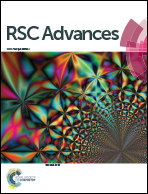Nanoporous gold–copper oxide based all-solid-state micro-supercapacitors†
Abstract
The rapid growth of miniaturized electronic devices has increased the demand for energy storage devices with small dimensions. Micro-supercapacitors have great potential to supplement or replace batteries and electrolytic capacitors for a wide range of applications. Micro-supercapacitor can be fabricated with micro-electronic devices for efficient energy storage unit. However, the lower energy densities of micro-supercapacitors are still a bigger challenge to its application in micro devices. In this paper, we report all-solid-state nanoporous gold (NPG)–copper oxide (CuO) based micro-supercapacitor prepared using a simple fabrication process. In this process, first NPG interdigital patterns were developed by using a simple annealing and dealloying procedure, and then CuO was electrodeposited on NPG interdigital microelectrodes. The nanoporous gold substrate provides good electronic/ionic conductivity with high intrinsic surface area for the electrodeposition of CuO, which forms a novel hybrid electrode. The NPG–CuO micro-supercapacitor exhibits maximum areal capacitance 26 mF cm−2, maximum specific energy 3.6 μW h cm−2 and maximum specific power 646 μW cm−2. NPG–CuO micro-supercapacitors show excellent cyclic stability with 98% capacitance retention after 10 000 cycles.


 Please wait while we load your content...
Please wait while we load your content...